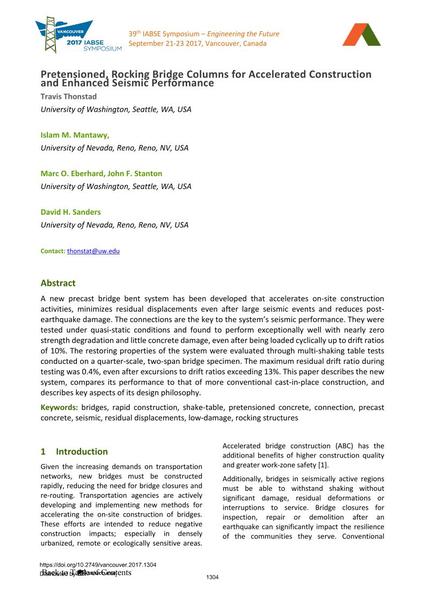Pretensioned, Rocking Bridge Columns for Accelerated Construction and Enhanced Seismic Performance

|
|
|||||||||||
Détails bibliographiques
| Auteur(s): |
Travis Thonstad
(University of Washington, Seattle, WA, USA)
Islam M. Mantawy (University of Nevada, Reno, Reno, NV, USA) Marc O. Eberhard (University of Washington, Seattle, WA, USA) John Stanton (University of Washington, Seattle, WA, USA) David H. Sanders (University of Nevada, Reno, Reno, NV, USA) |
||||
|---|---|---|---|---|---|
| Médium: | papier de conférence | ||||
| Langue(s): | anglais | ||||
| Conférence: | IABSE Symposium: Engineering the Future, Vancouver, Canada, 21-23 September 2017 | ||||
| Publié dans: | IABSE Symposium Vancouver 2017 | ||||
|
|||||
| Page(s): | 1304-1311 | ||||
| Nombre total de pages (du PDF): | 8 | ||||
| Année: | 2017 | ||||
| DOI: | 10.2749/vancouver.2017.1304 | ||||
| Abstrait: |
A new precast bridge bent system has been developed that accelerates on-site construction activities, minimizes residual displacements even after large seismic events and reduces post- earthquake damage. The connections are the key to the system’s seismic performance. They were tested under quasi-static conditions and found to perform exceptionally well with nearly zero strength degradation and little concrete damage, even after being loaded cyclically up to drift ratios of 10%. The restoring properties of the system were evaluated through multi-shaking table tests conducted on a quarter-scale, two-span bridge specimen. The maximum residual drift ratio during testing was 0.4%, even after excursions to drift ratios exceeding 13%. This paper describes the new system, compares its performance to that of more conventional cast-in-place construction, and describes key aspects of its design philosophy. |
||||
| Mots-clé: |
ponts
|
||||
